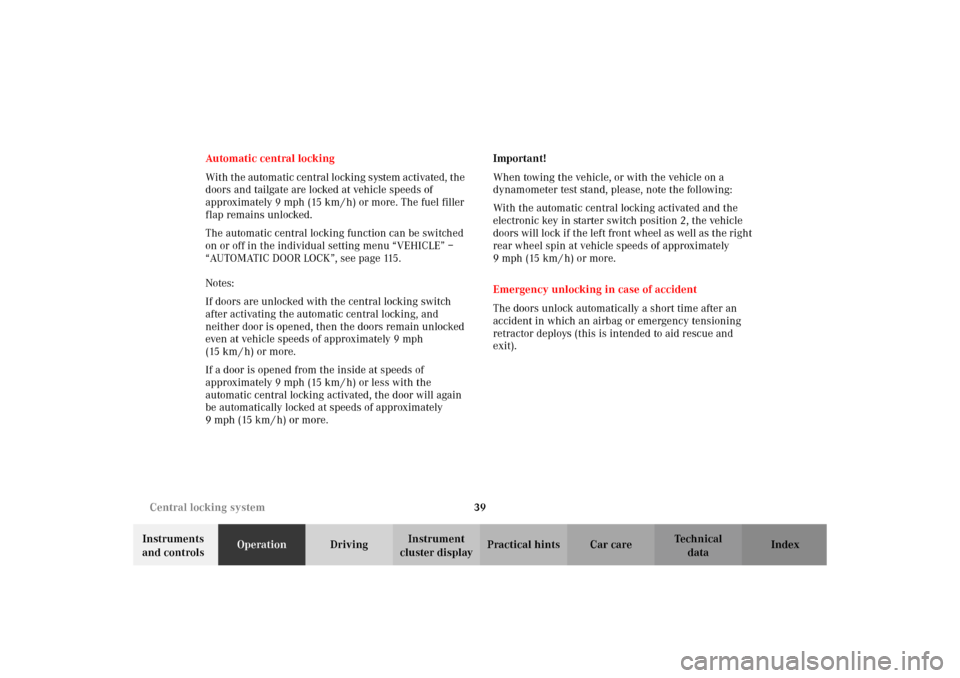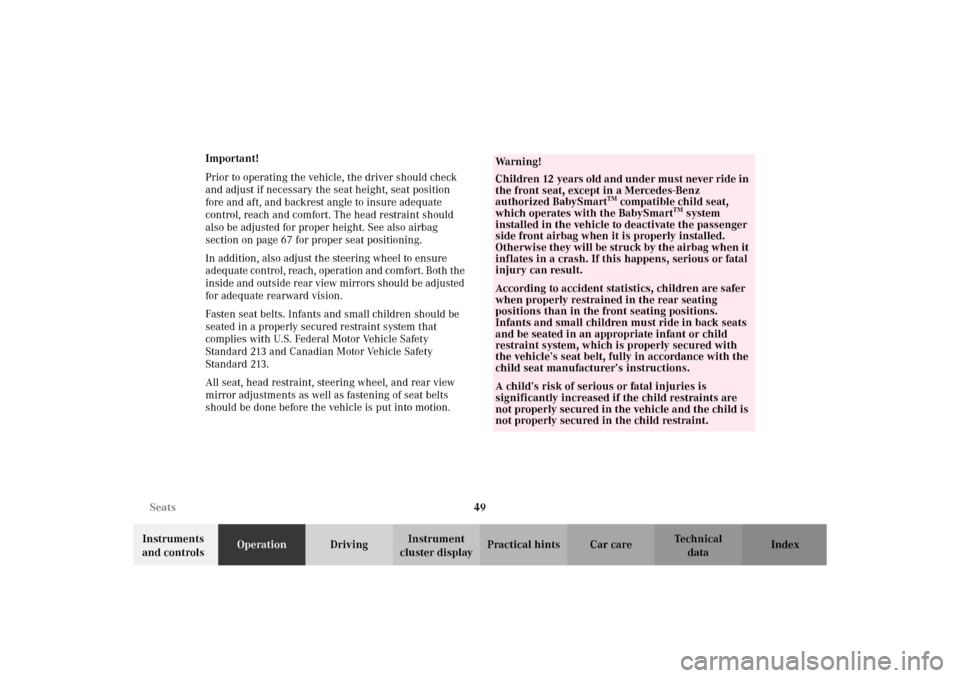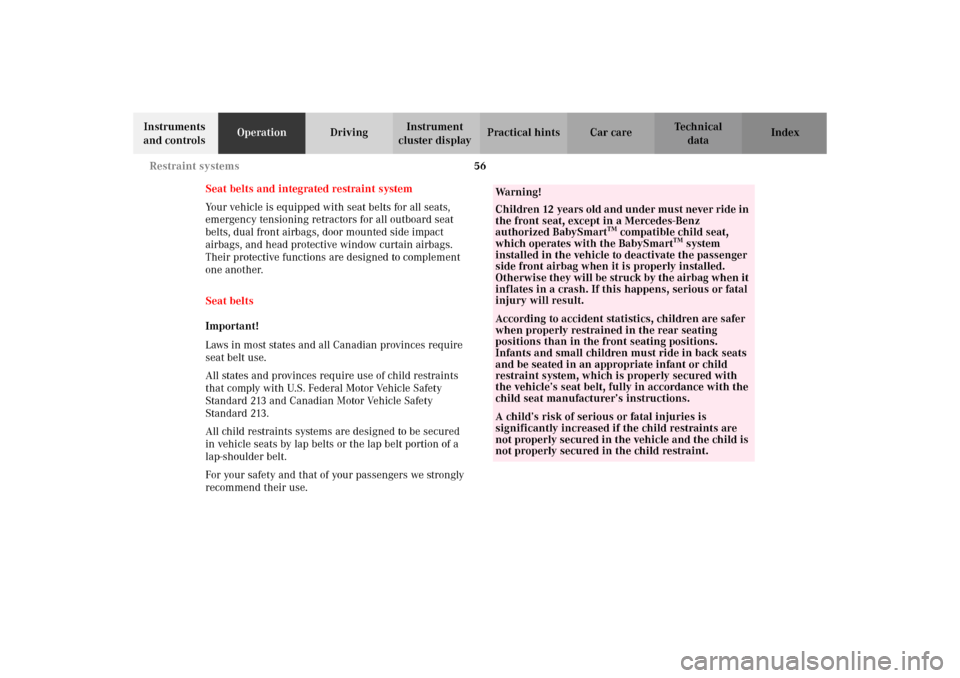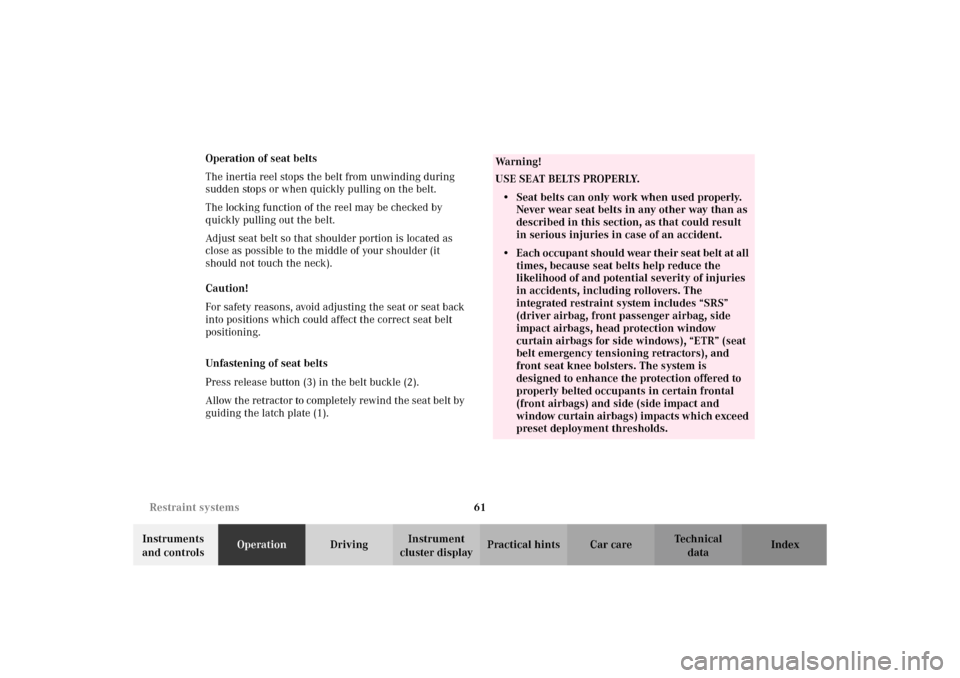2002 MERCEDES-BENZ C320 WAGON airbag
[x] Cancel search: airbagPage 4 of 390

1 Contents
IntroductionProduct information .......................... 7
Operator’s manual ............................. 8
Where to find it ................................ 13
Reporting Safety Defects ................ 15Instruments and controlsInstruments and controls ............... 18
Door control panel ....................... 20
Overhead control panel ............... 21
Dashboard ..................................... 22
Center console .............................. 24OperationVehicle keys ...................................... 28
Start lock-out .................................... 30
General notes on the
central locking system ............... 30
Central locking system ................... 31
Radio frequency and
infrared remote control ............... 31
Locking and unlocking ................ 33Choosing global or selective
mode on remote control ............. 33
Opening and closing windows
and sliding / pop-up roof
from outside ................................. 34
Panic button ................................. 35
Mechanical keys .......................... 35
Doors ................................................. 36
Central locking switch .................... 38
Automatic central locking .............. 39
Emergency unlocking
in case of accident ...................... 39
Tailgate .............................................. 40
Opening the tailgate .................... 40
Emergency unlocking
the tailgate .....................................41
Closing the tailgate ..................... 42
Antitheft alarm system ................... 43
Tow-away alarm ............................... 44
Easy-entry/exit feature .................. 45
Front seat adjustment ..................... 46
Removal and installation of
front seat head restraints .......... 50
Multicontour seat .............................51Heated seats ..................................... 52
Rear seat head restraints ................ 53
Seat belts and integrated
restraint system .......................... 56
Seat belts ........................................... 56
Seat belt nonusage
warning system ........................... 57
BabySmart
TM airbag
deactivation system .................... 64
Supplemental Restraint
System (SRS) ............................... 65
Emergency tensioning
retractor (ETR) ............................. 66
Airbags .............................................. 67
Safety guidelines for the seat
belt, emergency tensioning
retractor and airbag .................... 75
Infant and child
restraint systems ......................... 77
Steering wheel adjustment
(electrical) .................................... 83
Rear view mirrors ............................ 84
Instrument cluster ........................... 92
Multifunction steering wheel,
multifunction display ................. 96
S203.book Seite 1 Freitag, 19. Oktober 2001 1:25 13
Page 7 of 390

4 Contents
DrivingControl and operation of
radio transmitters .....................226
The first 1 000 miles
(1 500 km) .................................227
Maintenance ...................................227
Tele Aid ...........................................228
Catalytic converter ........................238
Emission control ............................239
Starter switch .................................240
Starting and turning off
the engine ..................................242
Automatic transmission ...............243
Parking brake .................................252
Driving instructions ......................253
Drive sensibly – Save Fuel ........253
Drinking and driving .................253
Pedals ...........................................253
Power assistance ........................254
Brakes ..........................................254
Driving off ...................................255
Parking ........................................256
Tires .............................................257Snow chains ............................... 259
Winter driving
instructions ................................ 260
Deep water .................................. 262
Passenger compartment ........... 263
Traveling abroad ........................ 263
Cruise control ................................ 264
Brake assist system (BAS) ............ 267
Antilock brake system
(ABS) .......................................... 268
Electronic stability program
(ESP) ........................................... 270
What you should know
at the gas station .......................274
Check regularly and
before a long trip .......................276
Instrument cluster displayMalfunction and indicator lamps in
the instrument cluster ............. 278
On-board diagnostic system ........ 278
Check engine malfunction
indicator lamp ............................ 278
Brake warning lamp .................. 280Supplemental restraint system
(SRS) indicator lamp .................. 281
Fuel reserve warning .................282
ABS malfunction
indicator lamp .............................283
Electronic stability program
(ESP) — warning lamp ...............284
Seat belt nonusage
warning lamp ............................284
Malfunction and indicator
lamp in the center console ......284
AIRBAG OFF indicator lamp .....284
Malfunction and warning
messages in the
multifunction display ...............285
DISPLAY DEFECTIVE ................287
BATTERY / ALTERNATOR ........288
ANTILOCK BRAKE SYSTEM ....289
BRAKE ASSIST ...........................289
BRAKE PAD WEAR ....................290
BRAKE FLUID .............................290
PARKING BRAKE ....................... 291
SEAT BELT SYSTEM ................... 291
S203.book Seite 4 Freitag, 19. Oktober 2001 1:25 13
Page 27 of 390

24 Instruments and controls
Te ch n i c a l
data Instruments
and controlsOperation DrivingInstrument
cluster displayPractical hints Car care Index
Center console1Left front seat heater switch, see page 52
2Rear window wiper/washer, see page 146
3ESP (electronic stability program) control switch,
see page 270
4Hazard warning flasher switch, see page 147
5Central locking switch, see page 38
6Antitheft alarm system, see page 43
Switch for tow-away protection, see page 44
7Right front seat heater switch, see page 52
8AIRBAG OFF indicator lamp, see page 284
9COMAND system (optional), see separate
operating instructions, or
audio system, see page 161
10Automatic climate control, see page 148
Rear window defroster, see page 158
11Ashtray, see page 200
12Automatic transmission, see page 243
13Storage compartment, see page 196
14Armrest, see page 196
Storage compartment, see page 202
S203.book Seite 24 Freitag, 19. Oktober 2001 1:25 13
Page 29 of 390

26 Contents - Operation
Te ch n i c a l
data Instruments
and controlsOperationDrivingInstrument
cluster displayPractical hints Car care Index
OperationVehicle keys ...................................... 28
Start lock-out .................................... 30
General notes on the
central locking system ............... 30
Central locking system ................... 31
Radio frequency and
infrared remote control ............... 31
Locking and unlocking ................ 33
Choosing global or selective
mode on remote control .............. 33
Opening and closing windows
and sliding / pop-up roof
from outside .................................. 34
Panic button .................................. 35
Mechanical keys ........................... 35
Doors .................................................. 36
Central locking switch .................... 38
Automatic central locking .............. 39
Emergency unlocking
in case of accident ...................... 39
Tailgate .............................................. 40
Opening the tailgate .................... 40Emergency unlocking
the tailgate .....................................41
Closing the tailgate ..................... 42
Antitheft alarm system ................... 43
Tow-away alarm ............................... 44
Easy-entry/exit feature .................. 45
Front seat adjustment ..................... 46
Removal and installation of
front seat head restraints .......... 50
Multicontour seat .............................51
Heated seats ..................................... 52
Rear seat head restraints ............... 53
Seat belts and integrated
restraint system .......................... 56
Seat belts .......................................... 56
Seat belt nonusage
warning system .......................... 57
BabySmart
TM airbag
deactivation system ................... 64
Supplemental Restraint
System (SRS) ............................... 65
Emergency tensioning
retractor (ETR) ............................ 66
Airbags .............................................. 67Safety guidelines for the seat
belt, emergency tensioning
retractor and airbag .................... 75
Infant and child
restraint systems ......................... 77
Steering wheel adjustment
(electrical) .................................... 83
Rear view mirrors ............................ 84
Instrument cluster ........................... 92
Multifunction steering wheel,
multifunction display ................. 96
Trip and main odometer
and sub menu ............................ 100
Audio systems ................................ 102
Radio ............................................ 102
CD player ..................................... 103
Cassette player ........................... 104
Telephone ........................................ 105
Navigation system ...........................110
Trip computer .................................. 111
Malfunction/warning
message memory .......................113
Individual settings ..........................115
Setting the audio volume ............. 130
S203.book Seite 26 Freitag, 19. Oktober 2001 1:25 13
Page 42 of 390

39 Central locking system
Te ch n i c a l
data Instruments
and controlsOperationDrivingInstrument
cluster displayPractical hints Car care Index Automatic central locking
Wit h t he autom atic c entral lockin g s ystem ac tivate d, t he
doors and tailgate are locked at vehicle speeds of
approximately 9 mph (15 km / h) or more. The fuel filler
flap remains unlocked.
The automatic central locking function can be switched
on or off in the individual setting menu “VEHICLE” –
“AUTOMATIC DOOR LOCK”, see page 115.
Notes:
If doors are unlocked with the central locking switch
after activating the automatic central locking, and
neither door is opened, then the doors remain unlocked
even at vehicle speeds of approximately 9 mph
(15 km / h) or more.
If a door is opened from the inside at speeds of
approximately 9 mph (15 km / h) or less with the
automatic central locking activated, the door will again
be automatically locked at speeds of approximately
9 mph (15 km / h) or more.Important!
When towing the vehicle, or with the vehicle on a
dynamometer test stand, please, note the following:
With the automatic central locking activated and the
electronic key in starter switch position 2, the vehicle
doors will lock if the left front wheel as well as the right
rear wheel spin at vehicle speeds of approximately
9 mph (15 km / h) or more.
Emergency unlocking in case of accident
The doors unlock automatically a short time after an
accident in which an airbag or emergency tensioning
retractor deploys (this is intended to aid rescue and
exit).
S203.book Seite 39 Freitag, 19. Oktober 2001 1:25 13
Page 52 of 390

49 Seats
Te ch n i c a l
data Instruments
and controlsOperationDrivingInstrument
cluster displayPractical hints Car care Index Important!
Prior to operating the vehicle, the driver should check
and adjust if necessary the seat height, seat position
fore and aft, and backrest angle to insure adequate
control, reach and comfort. The head restraint should
also be adjusted for proper height. See also airbag
section on page 67 for proper seat positioning.
In addition, also adjust the steering wheel to ensure
ad eq uate con tr ol, r each, operation and com fort. B ot h the
inside and outside rear view mirrors should be adjusted
for adequate rearward vision.
Fasten seat belts. Infants and small children should be
seated in a properly secured restraint system that
complies with U.S. Federal Motor Vehicle Safety
Standard 213 and Canadian Motor Vehicle Safety
Standard 213.
All seat, head restraint, steering wheel, and rear view
mirror adjustments as well as fastening of seat belts
should be done before the vehicle is put into motion.
Wa r n i n g !
Children 12 years old and under must never ride in
the front seat, except in a Mercedes-Benz
authorized BabySmart
TM compatible child seat,
which operates with the BabySmart
TM system
installed in the vehicle to deactivate the passenger
side front airbag when it is properly installed.
Otherwise they will be struck by the airbag when it
inflates in a crash. If this happens, serious or fatal
injury can result.
According to accident statistics, children are safer
when properly restrained in the rear seating
positions than in the front seating positions.
Infants and small children must ride in back seats
and be seated in an appropriate infant or child
restraint system, which is properly secured with
the vehicle’s seat belt, fully in accordance with the
child seat manufacturer’s instructions.A child’s risk of serious or fatal injuries is
significantly increased if the child restraints are
not properly secured in the vehicle and the child is
not properly secured in the child restraint.
S203.book Seite 49 Freitag, 19. Oktober 2001 1:25 13
Page 59 of 390

56 Restraint systems
Te ch n i c a l
data Instruments
and controlsOperationDrivingInstrument
cluster displayPractical hints Car care Index
Seat belts and integrated restraint system
Your vehicle is equipped with seat belts for all seats,
emergency tensioning retractors for all outboard seat
belts, dual front airbags, door mounted side impact
airbags, and head protective window curtain airbags.
Their protective functions are designed to complement
one another.
Seat belts
Important!
Laws in most states and all Canadian provinces require
seat belt use.
All states and provinces require use of child restraints
that comply with U.S. Federal Motor Vehicle Safety
Standard 213 and Canadian Motor Vehicle Safety
Standard 213.
All child restraints systems are designed to be secured
in vehicle seats by lap belts or the lap belt portion of a
lap-shoulder belt.
For your safety and that of your passengers we strongly
recommend their use.
Wa r n i n g !
Children 12 years old and under must never ride in
the front seat, except in a Mercedes-Benz
authorized BabySmart
TM compatible child seat,
which operates with the BabySmart
TM system
installed in the vehicle to deactivate the passenger
side front airbag when it is properly installed.
Otherwise they will be struck by the airbag when it
inflates in a crash. If this happens, serious or fatal
injury will result.
According to accident statistics, children are safer
when properly restrained in the rear seating
positions than in the front seating positions.
Infants and small children must ride in back seats
and be seated in an appropriate infant or child
restraint system, which is properly secured with
the vehicle’s seat belt, fully in accordance with the
child seat manufacturer’s instructions.A child’s risk of serious or fatal injuries is
significantly increased if the child restraints are
not properly secured in the vehicle and the child is
not properly secured in the child restraint.
S203.book Seite 56 Freitag, 19. Oktober 2001 1:25 13
Page 64 of 390

61 Restraint systems
Te ch n i c a l
data Instruments
and controlsOperationDrivingInstrument
cluster displayPractical hints Car care Index Operation of seat belts
The inertia reel stops the belt from unwinding during
sudden stops or when quickly pulling on the belt.
The locking function of the reel may be checked by
quickly pulling out the belt.
Adjust seat belt so that shoulder portion is located as
close as possible to the middle of your shoulder (it
should not touch the neck).
Caution!
For safety reasons, avoid adjusting the seat or seat back
into positions which could affect the correct seat belt
positioning.
Unfastening of seat belts
Press release button (3) in the belt buckle (2).
Allow the retractor to completely rewind the seat belt by
guiding the latch plate (1).
Wa r n i n g !
USE SEAT BELTS PROPERLY.• Seat belts can only work when used properly.
Never wear seat belts in any other way than as
described in this section, as that could result
in serious injuries in case of an accident.• Each occupant should wear their seat belt at all
times, because seat belts help reduce the
likelihood of and potential severity of injuries
in accidents, including rollovers. The
integrated restraint system includes “SRS”
(driver airbag, front passenger airbag, side
impact airbags, head protection window
curtain airbags for side windows), “ETR” (seat
belt emergency tensioning retractors), and
front seat knee bolsters. The system is
designed to enhance the protection offered to
properly belted occupants in certain frontal
(front airbags) and side (side impact and
window curtain airbags) impacts which exceed
preset deployment thresholds.
S203.book Seite 61 Freitag, 19. Oktober 2001 1:25 13